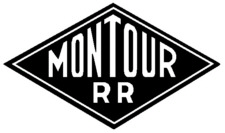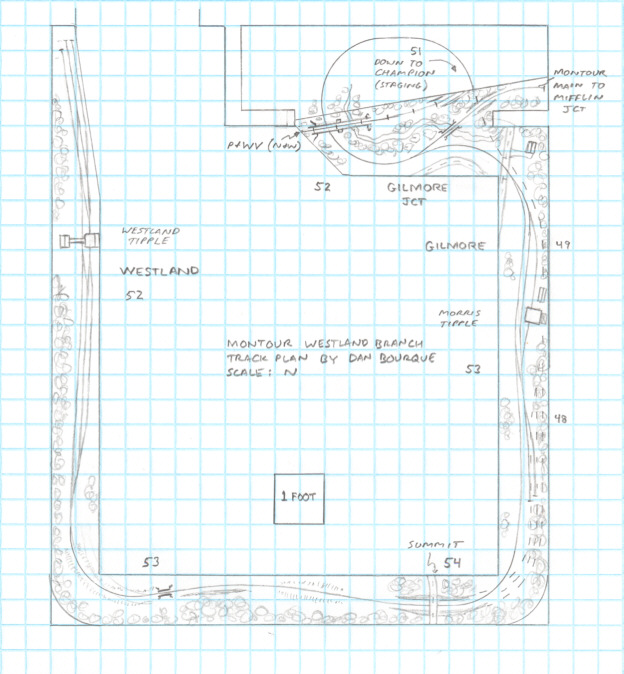- Size: 10’x12′
- Scale: N
- Minimum Radius: 15″
- Minimum Aisle Width: 32″
- Designed by Dan Bourque
 The Montour’s 4-mile long Westland Branch extended south from the Montour mainline to serve two coal tipples. It was constructed as the “Midland Spur” in 1922, and for most of its 60-year existence, it served the Westland Tipple at the end of the branch and the Morris Tipple near the junction with the mainline. This bedroom-sized N-scale layout represents the branch during the diesel era when it was served by the Montour’s fleet of SW9 switchers.
The Montour’s 4-mile long Westland Branch extended south from the Montour mainline to serve two coal tipples. It was constructed as the “Midland Spur” in 1922, and for most of its 60-year existence, it served the Westland Tipple at the end of the branch and the Morris Tipple near the junction with the mainline. This bedroom-sized N-scale layout represents the branch during the diesel era when it was served by the Montour’s fleet of SW9 switchers.
The Layout
This layout is a very simple around-the-walls arrangement for a small bedroom and is designed to capture the operations of the branch while still leaving plenty of room for a bed, office, etc. (though it does occupy all the closet space). A small staging yard is located under the layout and represents the large coal prep plant at Champion, the destination for the coal which originated on the branch.
A simple loop brings the Montour main up from staging, and the nearby N&W (former P&WV) bridge provides a convenient way to disguise the transition through the backdrop. The branch is significantly compressed, but the two main customers are well represented, and there’s enough running room between the junction and Westland to create some separation between the scenes. Grades are prototypical with a summit along the branch requiring Westland’s loads to be moved uphill on the branch’s 1.5% grade.
Because of the small size and limited locomotives needed, an entry-level DCC system with a walk-around throttle would be more than adequate to power the layout.
Operations
Operations are simple but could keep one or two operators busy for an hour. From a big picture standpoint, mine runs on the Montour in the diesel era were called out of Coraopolis, PA and primarily served to supply hoppers to the handful of tipple operations and collect the “green coal” (raw coal) loads for delivery to the large prep plant at Champion, PA. Because of the steep grade against the loads at Westland, sets of four SW9s were common mine run power on this branch.
The mine run would leave staging with empties for the branch. The Morris Tipple was a sporadic operation, so if it’s in service, the first stop would be to supply empties into the two stub tracks beyond the tipple, something that would take more moves than you might think. After serving Morris, the remainder of the mine run would climb the 2% grade to the summit and drift down to Westland where empties would be placed in the double-ended tracks in front of the tipple. Next is collecting the loads from the three stub tracks which would be tricky with the run arounds covered in empties.
When the loads are gathered and the train put together, the SW9s would struggle upgrade back toward Gilmore Jct. On the prototype, each SW9 was rated for 11 loads on this branch, so that could be scaled down to require doubling the hill if only two or three SW9s are available. The last move would be collecting the loads at Morris Tipple before heading back to Champion.
What I Like About this Plan:
- Simple construction
- Prototypical operations
- True “shelf” footprint allowing multiple uses for room
What I Don’t Like About this Plan:
- Little variation in operations
Related Products:




